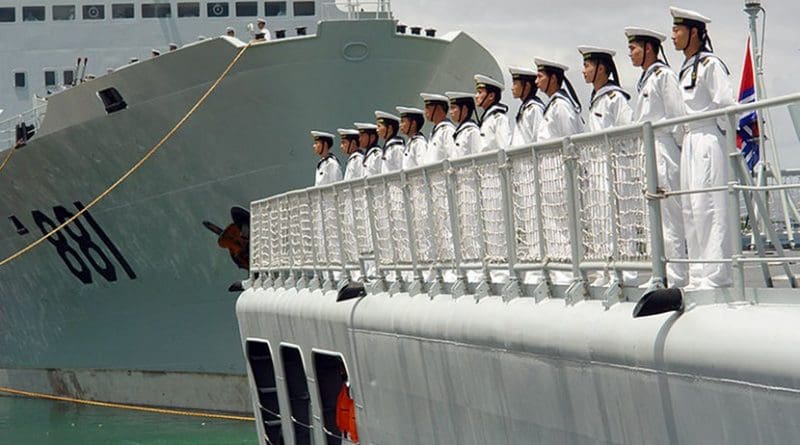Linking US–Russian Arms Control To East Asian Security – Analysis
By Marianne Hanson*
The idea of arms control — working with one’s adversaries to prevent costly arms build-up or achieve strategic stability — appears deeply unfashionable in today’s world. Almost every arms control agreement between Washington and Moscow has ended. All nine of the world’s nuclear weapon states are modernising and refining their nuclear capabilities.
As long as any state holds nuclear weapons, the risk of nuclear conflict is real. Nuclear war was ranked as one of the top three concerns of 1000 political and business leaders surveyed at the World Economic Forum in 2018.
While the actual risk might be small, the consequences would be catastrophic. During the Cold War, the Eastern and Western blocs managed this risk through arms control treaties and confidence-building measures designed to increase military transparency, avoid misperceptions, and reduce the chances of armed conflict.
In the Asia Pacific region, no such embedded and regularised restraints exist.
The Asia Pacific hosts four nuclear weapon states and is affected by hostile rivalry between two others: the United States and Russia. It is home to perhaps the world’s most dangerously volatile relationship between nuclear states — India and Pakistan — and is the only region where nuclear weapons testing has been conducted this century (by North Korea).
Asia’s two superpowers, China and India, have engaged in border clashes, with the most recent skirmish killing 20 Indian soldiers. While the risk of nuclear escalation was low, it could not be completely ruled out.
China’s expanding military and naval capabilities cannot be ignored. It was the second largest military spender in the world in 2019. Like India and Pakistan, China is also increasing its stock of nuclear warheads and reinforcing its nuclear triad. A recent display of its military hardware revealed new missiles such as the Dongfeng-41 and the Dongfeng-17. In April 2020, China deployed two new submarines, capable of carrying nuclear armed ballistic missiles.
These developments are troubling to the West. US President Donald Trump wants to see Beijing brought into a trilateral nuclear arms control process with Russia. Critics point out that China’s intermediate-range missile program has never been constrained in the way that it was for Washington and Moscow.
Yet Trump’s decision to end the Intermediate Nuclear Forces Treaty in February 2019 (with Russia following suit the next day), his withdrawal from the Open Skies Treaty and his evisceration of the Iran nuclear deal do not bode well. These actions undermine the potential for a meaningful partnership where Beijing would trust US declarations.
The sole remaining nuclear arms control agreement between Washington and Moscow, the Strategic Arms Reduction Treaty (New START), will expire in February 2021. While Putin is prepared to extend it for a further five years, Trump is stalling. He seems to believe that New START should not be extended unless China is brought into nuclear discussions.
This will not happen. China’s nuclear arsenal only numbers around 320 weapons, compared to the United States’ 5800 and Russia’s 6375, together accounting for over 90 per cent of global nuclear stocks. China has no incentive to participate in a process where at least one of the parties is seen as unreliable and erratic.
China asserts that its weapons are for defensive purposes only and continues to declare a ‘no-first-use’ nuclear policy, something that the United States and Russia refuse to do. It will not contemplate curbing its nuclear and missile systems until the United States and Russia come down to similarly low levels of warheads.
This is where the United States and Russia can help to secure a safer nuclear landscape. By extending New START and reducing their warhead numbers substantially, they have a better chance of bringing Beijing into discussions. Extending New START could be a means for eventually incorporating China into a broader trilateral arms control agenda.
It seems unlikely that arms control can progress under a Trump presidency. In addition to treaty withdrawals, Trump has threatened to test nuclear weapons, and appears incapable of participating in serious diplomatic exchanges with Moscow, Beijing or Pyongyang.
Australia’s recent actions are unfortunately worsening this situation. Canberra’s announcement that it will pursue long-range missiles and other advanced weapon systems does nothing to encourage strategic stability in the region. Rather it will, as Tanya Ogilvie-White argues, ‘feed the flames’ of missile proliferation. Adding to the missile fray will send a message that all states should engage in costly arms build-ups. This will only escalate regional tensions and heighten security dilemmas.
There are things that Australia could do to try to stabilise the region. As a middle power, Australia has in the past sought to influence the nuclear policies of great powers — the Canberra Commission and the International Commission on Nuclear Non-Proliferation and Disarmament are cases in point. It can leverage the US desire to bring China into negotiations by encouraging Washington and Moscow to lower their own nuclear numbers.
There is a clear need for a firmer security framework in East and South Asia that emphasises confidence-building measures and cooperative security processes. Competition between major powers will continue, but this can be regulated, as it was in the Cold War, to enable coexistence and to avoid (intentional or accidental) war.
China supposedly wants to demonstrate its responsible international leadership. Australia and China can find common ground by reasserting the need for serious arms control, encouraging Washington and Moscow to reduce the size of their nuclear arsenals and rebuilding strategic dialogues with all partners.
*About the author: Marianne Hanson is Associate Professor at the School of Political Science and International Studies at the University of Queensland.
Source: This article was published by East Asia Forum

